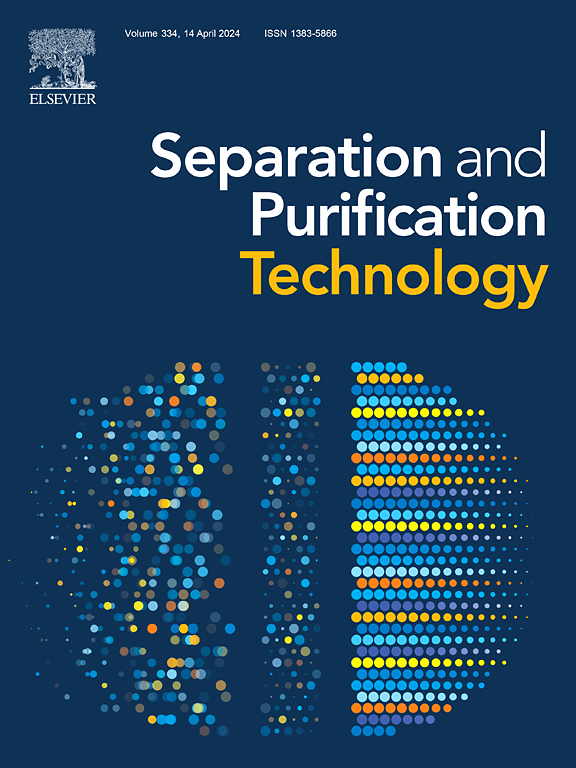From waste to functional Material: Recycling High-Impact polystyrene (HIPS) with clove extract for air filtration media with antibacterial activity
IF 8.1
1区 工程技术
Q1 ENGINEERING, CHEMICAL
引用次数: 0
Abstract
The extensive use of plastics, particularly High-Impact Polystyrene (HIPS), has resulted in significant waste accumulation, with low recycling rates posing a serious environmental challenge. Simultaneously, the degradation of air quality due to fine particulate matter (PM2.5), which increased health risks, and the limitations of commercially masks without antibacterial activity that could only be used for a few hours, led to the development of more efficient air filtration solutions and increased the lifetime of masks. In this study, nanofiber membranes based on recycled High-Impact Polystyrene (HIPS) with the addition of clove extract were successfully synthesized using the electrospinning method. Various concentrations of clove extract (0 %, 1 %, 3 %, and 5 %) were incorporated to investigate their effects on fiber morphology, membrane properties, and performance. SEM analysis showed that the average fiber diameter decreased as the clove extract concentration increased, but uniformity declined, as indicated by higher coefficients of variation (CV). XRD analysis confirmed an amorphous structure, while FTIR and Raman spectroscopy indicated the integration of the extract without residual solvent. Contact angle measurements confirmed that all membranes exhibited hydrophobic characteristics. The HC5 membrane (5 % clove extract) demonstrated antibacterial activity against Staphylococcus aureus and Escherichia coli and exhibited comparable performance to Chloramphenicol against Pseudomonas aeruginosa in growth kinetic tests. Filtration tests showed that fiber morphology significantly influenced performance. The HC5 membrane exhibited a low-pressure drop (7.40 Pa) but had limited filtration efficiency (52.66 %) due to uneven fiber distribution and large pore size variations. However, optimizing the electrospinning duration enhanced filtration efficiency, achieving 99.95 % efficiency after 5 h, meeting FFP3/N99 standards. These findings demonstrate the potential of recycled HIPS nanofiber membranes with clove extract as a sustainable and effective air filtration solution.从废物到功能材料:回收高冲击聚苯乙烯(HIPS)与丁香提取物的空气过滤介质具有抗菌活性
塑料,特别是高冲击聚苯乙烯(HIPS)的广泛使用导致大量废物堆积,低回收率对环境构成严重挑战。与此同时,细颗粒物(PM2.5)导致空气质量恶化,增加了健康风险,而商用口罩缺乏抗菌活性,只能使用几个小时,这促使人们开发出更有效的空气过滤解决方案,并延长了口罩的使用寿命。本研究采用静电纺丝法合成了以回收高冲击聚苯乙烯(HIPS)为基材,加入丁香提取物的纳米纤维膜。加入不同浓度的丁香提取物(0 %、1 %、3 %和5 %),研究其对纤维形态、膜性能和性能的影响。扫描电镜分析表明,随着丁香提取物浓度的增加,平均纤维直径减小,但均匀性下降,变异系数(CV)较高。XRD分析证实其为无定形结构,FTIR和Raman光谱分析表明萃取物整合,无残留溶剂。接触角测量证实所有膜都表现出疏水特性。HC5膜(5 %丁香提取物)对金黄色葡萄球菌和大肠杆菌具有抑菌活性,在生长动力学试验中对铜绿假单胞菌的抑菌性能与氯霉素相当。过滤试验表明,纤维形态对性能有显著影响。HC5膜表现出较低的压降(7.40 Pa),但由于纤维分布不均匀和孔径变化大,过滤效率有限(52.66 %)。通过优化静电纺丝时间提高了过滤效率,5 h后的过滤效率达到99.95 %,达到FFP3/N99标准。这些发现证明了丁香提取物回收HIPS纳米纤维膜作为一种可持续有效的空气过滤溶液的潜力。
本文章由计算机程序翻译,如有差异,请以英文原文为准。
求助全文
约1分钟内获得全文
求助全文
来源期刊

Separation and Purification Technology
工程技术-工程:化工
CiteScore
14.00
自引率
12.80%
发文量
2347
审稿时长
43 days
期刊介绍:
Separation and Purification Technology is a premier journal committed to sharing innovative methods for separation and purification in chemical and environmental engineering, encompassing both homogeneous solutions and heterogeneous mixtures. Our scope includes the separation and/or purification of liquids, vapors, and gases, as well as carbon capture and separation techniques. However, it's important to note that methods solely intended for analytical purposes are not within the scope of the journal. Additionally, disciplines such as soil science, polymer science, and metallurgy fall outside the purview of Separation and Purification Technology. Join us in advancing the field of separation and purification methods for sustainable solutions in chemical and environmental engineering.
 求助内容:
求助内容: 应助结果提醒方式:
应助结果提醒方式:


